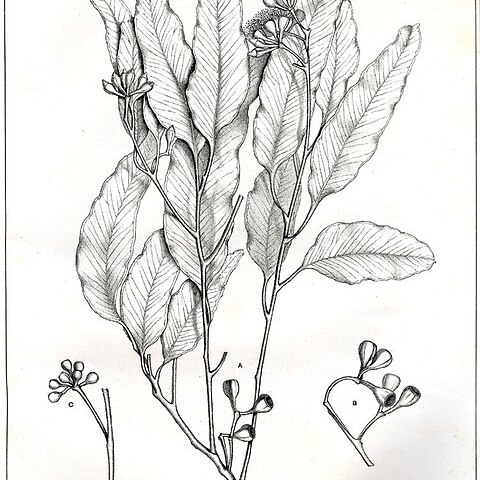Trees, large. Bark grayish, rough, persistent. Branchlets terete. Young leaves opposite, shortly petiolate; leaf blade broadly lanceolate to ovate, ca. 6 × 2-4 cm. Leaf blade of intermediate leaves broadly lanceolate, 8-10 × ca. 3.5 cm. Mature leaves with a 1-1.5 cm petiole; leaf blade lanceolate, 9-13 × 2-3 cm, slightly oblique, secondary veins at an angle of 40°-50° from midvein and conspicuous, intramarginal veins ca. 0.5 mm from margin. Inflorescences terminal, paniculate, umbels 3-9-flowered; peduncle ca. 1 cm, slightly ridged. Flower buds 7-9 mm. Hypanthium obovoid to obconic, 6-8 mm; stipe 2-10 mm; calyptra pyramidal awl-shaped, shorter than hypanthium, apex slightly acute. Capsule truncately capitate pyriform, 7-9 × ca. 5 mm; disk obscure; valves usually 4, equaling hypanthium rim or included. Fl. Aug-Oct.
Tree to 50 m. Bark rough throughout, light grey. Juvenile leaves ovate to broadly lanceolate, green, discolorous. Adult leaves lanceolate, acuminate; lamina 9.5–15 cm long, 1.2–2.4 cm wide, green, discolorous; lateral veins clearly visible, at 35°–45°; intramarginal vein up to 1 mm from margin; petiole 13–22 mm long. Peduncle terete, quadrangular or flattened, 6–16 mm long; pedicels 4-angled, 2–10 mm long. Buds obovoid to fusiform; operculum conical, usually narrower than hypanthium, 3–4 mm long and wide; hypanthium obovoid to obconical, 4–5 mm long and wide. Fruits hemispherical, obconical, obovoid or subpyriform, 6–8 mm long, 5–8 mm wide; disc obscure, descending; valves 4 or 5, level or included. Seeds shallowly reticulate.
Tree to 50 m with light grey rough bark throughout [deeply fissured].. Juvenile leaves ovate to broadly lanceolate; adult discolorous, lanceolate, 9.5–15 cm long, 1.2–2.4 cm wide; petiole 1.3–2.2 cm long.. Umbels 7-flowered in terminal panicles and also some axillary; peduncle terete, quadrangular or flattened, 0.6–1.6[2] cm long; pedicels 4-angled, 2–10 mm long.. Buds obovoid to fusiform; operculum conical, usually narrower than calyx-tube, 3–4 mm long and wide.. Calyx-tube obovoid to obconical, 4–5 mm long and wide.. Fruits hemispherical, obconical, obovoid or subpyriform, [5]6–8[8.5] mm long, 5–8 mm wide with obscure descending disc and 4–5 flush or included valves.. Fig. 8/28, p. 41 & 11/3–4, p. 51.
A tall straight tree. It grows 36 m high. The bark is deeply furrowed and grey. The leaves are dark green and glossy. They are paler underneath. The flowers are white. They are in small groups.
Umbels 3–9-flowered; peduncles 1–2 cm. long, subterete; pedicels 0·3–0·5 cm. long; buds 0·7 x 0·5 cm., broadly fusiform; operculum conical, subapiculate, ± equalling the receptacle-tube.
Fruit 0·7 x 0·5 cm., hemispherical-obconoidal; valves small, inserted near mouth.
Inflorescence terminal, paniculate, much shorter than the leaves.
Bark dark grey, hard, deeply furrowed, persistent throughout.
Leaves lanceolate, apex narrowly acute.
Tall tree.


